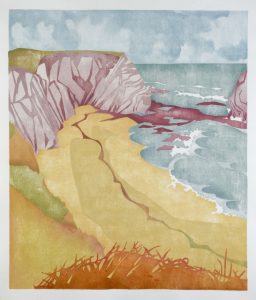I wasn’t expecting an exam. Certainly not a blind test, facing anonymous little pots of paint on Cranfield Colour’s board room table and the Managing Director’s stern questions. I thought I was going for a lovely sightseeing tour around the factory responsible for making my printing inks. Apparently I had to win the entry ticket with my clever answers first. It’s a tribute to MD Michael Craine’s charm that this scenario, which could so easily be me narrating a recurring nightmare, was both fun and illuminating. Could I tell which was modern oil paint and which a pre-industrial mix? Which sample came from Italy and which from the Netherlands?
There seemed little chance of getting anything right beyond a lucky guess, except I found I could. Once I had the sense to relax and trust to my gut feeling.

I dipped fingers into all pots, felt the paint, smelt it and smeared it about a bit, probably not best practice in a board room, and it all became clear. Mad as it sounds, the modern paint felt modern, the historic paint authentic, the Italian paint smelt of sun and the south, the Dutch paint of Northern chill and wide skies. I just needed to remember that I had this covered; I spend all my days around inks and paint. If I didn’t know intellectually, my fingers and nose would answer for me.
I don’t think this gut instinct gets enough of a shout when it comes to artistic practice, at least not when it comes to technique. There’s plenty spoken about ways in which artists are moved to create, but little said about their instinctive feel for method and materials. That essential understanding of how materials feel on any given day and what small adjustments in movement, mixing or application is needed to correct and improve them. It’s a shame because this wealth of instinctive knowledge is a beautiful thing. Watch any expert maker working and you can see how much they rely on instinct and experience. That magic only comes with putting in the hours and doing the work, but it’s an essential part of the job if an artist wants to excel.
I’m pleased to say that I did win the golden ticket, I did get to tour Cranfield Colours and enjoy all the delights of traditional paint and ink milling and mixing – and I got to feel like a worthy winner as well.
This week on Ask an Artist podcast we turn the tables on Michael Craine and ask him the questions. It’s a fantastic episode, full of helpful tips and some very interesting insights into all things paint, ink and pigments.



